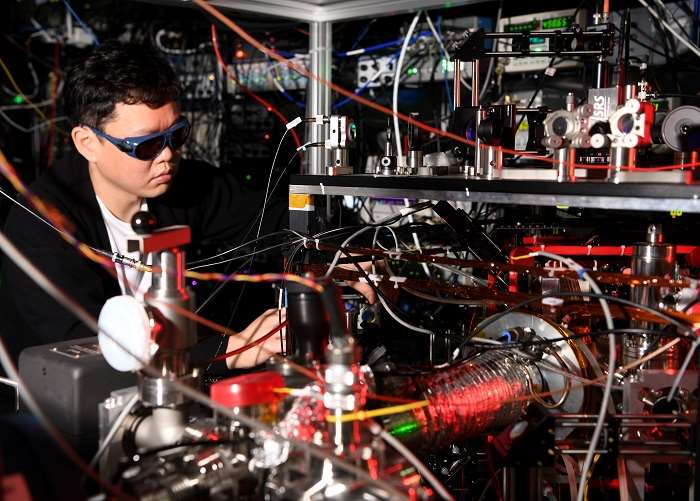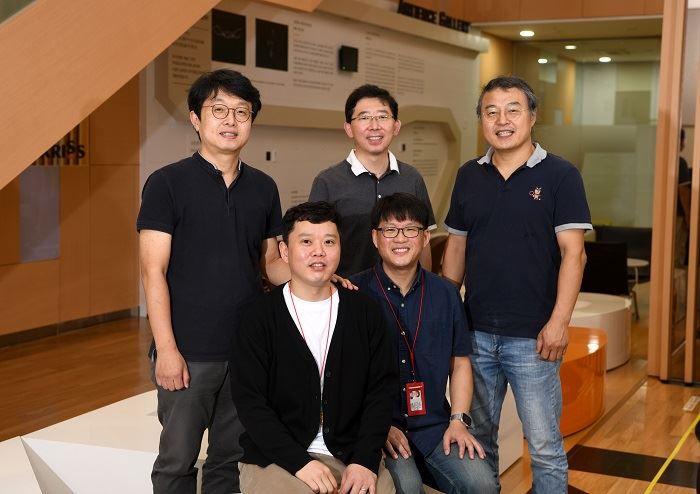The Korean Standard Becomes a Global Standard
- Writerkrissadmin
- Date2021-11-10 00:00
- Hits1983
The Korean Standard Becomes a Global Standard
- KRISS optical clock participates in calculation of UTC (Universal Time Coordinated) -
- 5th in the world after France, Japan, U.S. and Italy. Outcome of 20 years of research -

▲ KRISS Principal Research Scientist Huidong Kim conducts an experiment using the Ytterbium optical clock.
The ytterbium optical lattice clock ‘KRISS-Yb1’ developed by the Korea Research Institute of Standards and Science (KRISS, President Hyun-Min Park) has successfully joined the list of clocks used to calculate UTC (Universal Time Coordinated), the worldwide reference standard for time. With this, Korea became the fifth country in the world to contribute to the calculation of UTC with an optical clock, following France, Japan, the U.S. and Italy.
UTC (Universal Time Coordinated) is the international reference time scale, which allows the world to maintain a shared time system. All countries around the world use UTC to synchronize time, and UTC serves as a standard for e-commerce transactions, communications and navigation.
Until recently, UTC was based mainly on microwave cesium atomic clocks*, which are used in the definition of a second. However, with the development of optical clocks** with significantly more accurate than cesium atomic clocks, optical clocks in 4 countries with precision measurement technology have been participating in the calculation of UTC since 2016.
○ Currently, 1 second is defined using microwave cesium atomic clocks, with a frequency of approximately 9 billion Hz.. Optical clocks operate at frequencies in the range of 1015 Hz, and they are over 100 times more accurate. Thus, it is expected that the second will be redefined by optical clocks around 2030.
* Cesium atomic clock: current standard for the second, with a frequency of 9,192,631,770 periods per second. The cesium atom was adopted as the international standard at the General Conference on Weights and Measures held in 1967 in Paris.
** Optical clock: Future standard for the second, with a frequency of 51,829,583,659,863.6 periods per second, making it over 100 times more accurate than the cesium atomic clock.
To participate in UTC calculation, it is required to maintain an optical clock whose operation is accurate and stable. Measurement results of the clock taken over a period of at least 6 months should be submitted to the International Bureau of Weights and Measures(BIPM)*, the institution in charge of UTC calculation, and approval is made after a stringent review process. UTC is announced by the BIPM once a month.
* International Bureau of Weights and Measures (BIPM): International standards institute and bureau established under the Metre Convention, with the objective to achieve international equivalence in measurement units and standards used around the world.

▲ KRISS Atom-based Quantum Standards Team
(Clockwise from top left, Principal Research Scientists Won-Kyu Lee, Dai-Hyuk Yu,
Chang Yong Park, Myoung-Sun Heo, and Huidong Kim)
The KRISS Time and Frequency Group’s Atom-based Quantum Standards Team succeeded in participating in the calculation of UTC by improving the performance of its ytterbium optical clock ‘KRISS-Yb1’, some twentyfold since it was first developed in 2014. ‘KRISS-Yb1’ is accurate to an error of about 1 second in 2 billion years. The team measured the absolute frequency of the optical clock over 14 months from January 2020 to March 2021, to a level of accuracy close to the limit of the current definition of the second.
○ ‘KRISS-Yb1’ has been officially registered as a frequency standard for the steering of UTC by the BIPM. With this, Korea has become the fifth country in the world to contribute to the calculation of UTC with an optical clock, confirming its international leadership in the time standard.
‘KRISS-Yb1’ will not only participate in the generation of UTC, but also be used in the generation of Korean standard time, UTC(KRIS). The performance of internet and wireless networks as well as electrical grids can be improved through the operation of UTC(KRIS) and through accuracy enhancement. UTC(KRIS) is also expected to be used as a time standard for the Korean Positioning System (KPS).
Principal Research Scientist Won-Kyu Lee of the KRISS Time and Frequency Group said, “KRISS plans to develop the world’s most accurate optical clock ‘KRISS-Yb2’ by 2025 with an error smaller than 1 second over the age of the universe (approx. 13.8 billion years),” adding, “we also plan to play a leading role in the redefinition of the second in 2030 to boost the international status of Korea and build a foundation for the development of precision science.”
The outcomes of this study have been published online by Metrologia (IF: 3.447), a leading journal in the field of metrology.

